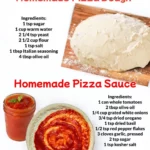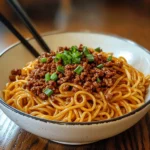Moussaka is a classic Greek dish, a baked casserole that layers tender eggplant, a rich meat sauce infused with warm spices, and a creamy, dreamy bechamel topping. It’s comfort food at its finest, a culinary hug that satisfies the soul with every bite. This recipe is a faithful adaptation of the traditional preparation, designed to bring the authentic flavors of Greece right to your table.
Why You Will Love This Recipe
- Authentic Flavors: This moussaka captures the true essence of Greek cuisine, combining the earthy taste of eggplant, the savory depth of a spiced meat sauce, and the velvety smoothness of a homemade bechamel.
- Impressive Yet Achievable: While it might seem daunting, this recipe breaks down the process into manageable steps, making it accessible even for home cooks who are new to Mediterranean cuisine.
- Perfect for Sharing: Moussaka is a dish best enjoyed with family and friends. Its hearty nature and comforting flavors make it ideal for gatherings, celebrations, or simply a cozy weeknight meal.
- Make-Ahead Friendly: You can assemble the moussaka a day in advance and bake it just before serving, making it a convenient option for busy schedules.
- Customizable: Feel free to adapt the recipe to your preferences. Use ground beef instead of lamb, add vegetables like zucchini or potatoes, or adjust the spices to your liking.
Ingredients:
For the Eggplant:
- 2 large globe eggplants
- Kosher salt
- Extra virgin olive oil
- 1/4 cup breadcrumbs
For the Meat Sauce:
- 1 large yellow onion, finely chopped
- 1 pound ground lamb or beef
- 1 tablespoon dried oregano
- 1 teaspoon ground cinnamon
- 1/2 teaspoon black pepper
- 1/2 teaspoon ground nutmeg
- 1/2 teaspoon paprika
- 1/2 cup red wine
- 1 (14 ounce) can diced tomatoes
- 1 teaspoon sugar
- 1/2 cup beef broth, warmed until simmering
For the Bechamel:
- 1/3 cup + 2 tablespoons extra virgin olive oil
- 2/3 cup all-purpose flour
- 1/2 teaspoon salt, plus more to taste
- Black pepper, to taste
- 4 cups 2% milk, warmed
- 1/4 teaspoon ground nutmeg
- 2 large eggs
Preparation:
Step 1: Prep the Eggplant:
Trim off the ends of the eggplants, then slice them into 1/4-inch thick slabs. Discard the outermost slices that are mostly skin. Spread the eggplant slices in a single layer on a large baking sheet or cutting board. Sprinkle generously with kosher salt. Let the eggplant sit for 30 minutes to “sweat out” its bitterness. This process draws out excess moisture and enhances the eggplant’s flavor and texture.
Step 2: Start the Meat Sauce:
While the eggplant is sweating, begin preparing the meat sauce. Heat 2 tablespoons of extra virgin olive oil in a large skillet or Dutch oven over medium heat. Add the finely chopped yellow onion and stir regularly until it becomes translucent and slightly golden brown, about 5 minutes. This step sweetens the onion and creates a flavorful base for the sauce.
Step 3: Brown the Meat:
Add the ground lamb or beef to the skillet with the softened onions. Use a spatula or wooden spoon to break up the meat and toss it regularly until it is fully browned on all sides. Ensure that there are no large clumps of meat remaining. Pour off any excess fat from the skillet to prevent the sauce from becoming greasy. Return the skillet to medium heat.
Step 4: Season the Meat Sauce:
Now it’s time to infuse the meat sauce with aromatic spices. Stir in the dried oregano, ground cinnamon, black pepper, ground nutmeg, and paprika. These spices create the signature warm and savory flavor profile of moussaka. Add the red wine and let it boil for 1 minute to reduce slightly, intensifying its flavor. Stir in the canned diced tomatoes, sugar, and hot beef broth. The sugar balances the acidity of the tomatoes and enhances the overall sweetness of the sauce.
Step 5: Simmer the Meat Sauce:
Reduce the heat to medium-low and let the meat sauce simmer gently for 20 to 30 minutes, or until it becomes rich, thick, and fragrant. Stir occasionally to prevent sticking and ensure even cooking. As the sauce simmers, the flavors will meld together, creating a complex and satisfying taste.
Step 6: Broil the Eggplant:
While the meat sauce simmers, preheat your oven’s broiler to high. Brush a large sheet pan with extra virgin olive oil to prevent the eggplant from sticking. Pat the eggplant slices dry with paper towels to remove excess salt and moisture. Assemble the eggplant slices in a single layer on the prepared pan, ensuring that they do not overlap. Work in batches or use two pans if necessary. Brush or coat the eggplant generously with olive oil on both sides to help them soften and brown evenly.
Step 7: Broil the Eggplant (cont.):
Place the sheet pan about 6 inches away from the broiler. Broil the eggplant briefly, turning it over so that both sides are softened and golden brown. Watch carefully to prevent burning. Some parts of the eggplant may become slightly charred, which adds to its flavor. Remove the eggplant from the oven and set aside.
Step 8: Preheat the Oven and Prepare the Baking Dish:
Turn off the broiler and preheat your oven to 350°F (175°C). Lightly oil a 9 1/2″ x 13″ oven-safe baking dish to prevent sticking.
Step 9: Make the Bechamel:
In a large saucepan, heat the olive oil over medium-high heat until it shimmers but not smokes. Stir in the all-purpose flour, salt, and a grind or pinch of black pepper. Cook, stirring continuously with a whisk, until the mixture turns golden, about 2-3 minutes. This process creates a roux, which will thicken the bechamel sauce. If needed, add a little more olive oil to prevent sticking.
Step 10: Make the Bechamel (cont.):
Gradually add the warmed milk to the roux, whisking continuously to prevent lumps from forming. Continue to cook, stirring occasionally, over medium heat until the sauce thickens enough to coat the back of a wooden spoon, about 5 to 7 minutes. Season with the ground nutmeg.
Step 11: Finish the Greek Bechamel:
In a small bowl, add the eggs. Whisk in a ladleful of the hot bechamel mixture to temper the eggs, preventing them from scrambling when added to the hot sauce. Slowly whisk the tempered egg mixture back into the bechamel sauce. Continue to stir or whisk the mixture, bringing it to a gentle boil for just 2 more minutes to ensure the eggs are fully cooked and the sauce is smooth. Taste and adjust the seasoning as needed. Remove the bechamel from the heat and allow it to cool and thicken slightly. The sauce should be creamy, thick, and smooth.
Step 12: Assemble the Moussaka:
Now it’s time to layer the ingredients in the prepared baking dish. Spread half of the broiled eggplant slices on the bottom of the dish, creating an even layer. Top with the meat sauce and spread it evenly over the eggplant. Add the remaining eggplant slices on top of the meat sauce, creating another even layer.
Step 13: Bake the Moussaka:
Pour the bechamel sauce over the eggplant, spreading it evenly to cover all of the eggplant slices. Sprinkle the top with breadcrumbs to add a crispy texture and golden-brown color. Bake the moussaka casserole on the center rack of the preheated oven for 45 minutes. If desired, transfer the baking pan to the top rack and broil briefly so that the top of the moussaka gains a nice golden-brown color. Watch carefully to prevent burning.
Step 14: Slice and Serve:
Remove the moussaka from the oven and let it sit for 10 minutes before slicing and serving. This allows the casserole to set slightly, making it easier to cut and serve. Slice the moussaka into squares and serve warm. Enjoy!
Cooking Rating:
5/5 Stars
Serving Suggestions:
- Serve moussaka as a main course with a side of Greek salad or crusty bread.
- Pair it with a dry red wine, such as Cabernet Sauvignon or Merlot.
- For a complete Greek feast, serve it alongside other classic dishes like tzatziki, dolmades, and spanakopita.
Tips:
- To save time, you can use store-bought bechamel sauce, but homemade is always best for flavor.
- If you don’t have beef broth, you can use chicken broth or vegetable broth instead.
- For a vegetarian version, replace the meat sauce with a lentil and vegetable mixture.
- Make sure to salt the eggplant generously to draw out excess moisture and bitterness.
- Don’t over-broil the eggplant, as it can become dry and tough.
Prep Time:
45 minutes
Cook Time:
1 hour 30 minutes
Total Time:
2 hours 15 minutes
Nutritional Information:
(Note: Nutritional information is an estimate and may vary based on specific ingredients and serving size.)
- Calories: 650
- Protein: 30g
- Sodium: 800mg
Conclusion:
Moussaka is more than just a recipe; it’s an experience. It’s a journey to Greece through the flavors of eggplant, spiced meat, and creamy bechamel. This recipe provides a comprehensive guide to creating this classic dish in your own kitchen, ensuring a delicious and satisfying result every time. So gather your ingredients, put on some Greek music, and prepare to embark on a culinary adventure that will transport you to the sunny shores of the Mediterranean. Kali Orexi! (Bon appétit!)
Questions and Answers:
Q1: Can I make moussaka ahead of time?
A: Yes, you can assemble the moussaka a day in advance and store it in the refrigerator. When you’re ready to bake, simply preheat your oven and bake as directed. You may need to add a few minutes to the baking time if the moussaka is cold.
Q2: Can I freeze moussaka?
A: Yes, you can freeze moussaka, but the texture of the bechamel sauce may change slightly upon thawing. To freeze, let the moussaka cool completely, then wrap it tightly in plastic wrap and aluminum foil. Freeze for up to 3 months. Thaw overnight in the refrigerator before reheating in the oven.
Q3: What can I substitute for lamb in the meat sauce?
A: If you don’t have lamb, you can use ground beef, ground turkey, or even a vegetarian meat substitute. The flavor will be slightly different, but the moussaka will still be delicious.
Q4: Can I add other vegetables to the moussaka?
A: Absolutely! Feel free to add other vegetables to the meat sauce, such as zucchini, potatoes, or bell peppers. Just make sure to cook the vegetables until they are tender before adding them to the sauce.
Q5: How do I prevent the bechamel sauce from getting lumpy?
A: To prevent lumps in the bechamel sauce, make sure to whisk the flour and olive oil together continuously until the mixture is smooth and golden. When adding the milk, add it gradually, whisking constantly to prevent lumps from forming. If lumps do form, you can strain the sauce through a fine-mesh sieve to remove them.




